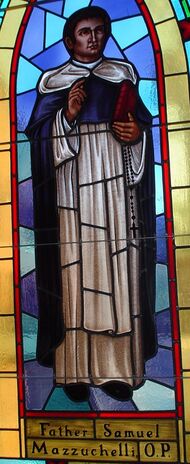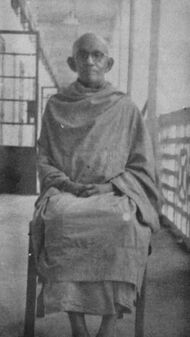The Venerable
Topic: Philosophy
 From HandWiki - Reading time: 3 min
From HandWiki - Reading time: 3 min

The Venerable is used as a style or epithet in several Christian churches. It is also the common English-language translation of a number of Buddhist titles, and is used as a word of praise in some cases.
Christianity
Catholic
In the Catholic Church, after a deceased Catholic has been declared a Servant of God by a bishop and proposed for beatification by the Pope, such a servant of God may next be declared venerable ("heroic in virtue") during the investigation and process leading to possible canonization as a saint. A declaration that a person is venerable, however, is not a pronouncement of their definitely being in Heaven. The pronouncement means it is considered likely that they are in heaven, but it is possible the person could still be undergoing purgation ("purgatory"). Before a person is considered to be venerable, that person must be declared as such by a proclamation, approved by the Pope, of having lived a life that was "heroic in virtue", the virtues being the theological virtues of faith, hope, and charity and the cardinal virtues of prudence, justice, fortitude, and temperance. The next steps are beatification, which normally requires a miracle by the intercession of the candidate, from which point the person is referred to as The Blessed. The blessed declaration very strongly implies the person is in heaven experiencing the beatific vision, but it is not actually infallible. Finally, the canonization process is consummated when the person intercedes in a miracle (normally, this is their second intercession) and the person is declared a saint. Exceptions to this pathway of canonization do exist.[1] The declaration of sainthood is definitive (infallible) only to the extent that the Catholic Church claims the person died in the state of grace and already enjoys beatific vision.[2]
For example, Popes Pius XII and John Paul II were both declared venerable by Pope Benedict XVI in December 2009, and John Paul II was declared a saint in 2014.[3]
Other examples of Venerables are Bishop Fulton J. Sheen, Princess Louise of France, Francis Libermann, and Mother Mary Potter.
The 7th/8th century English monk St Bede was referred to as venerable soon after his death and is still very often called "the Venerable Bede" despite having been canonized in 1899.
This is also the honorific used for hermits of the Carthusian Order, in place of the usual term of "Reverend".
Anglican
In the Anglican Communion, "The Venerable" (abbreviated as "the Ven.") is the style usually given to an archdeacon.[4]
Eastern Orthodoxy
In the Orthodox Church the term "Venerable" is commonly used as the English-language translation of the title given to monastic saints (Greek: Hosios, Church Slavonic: Prepodobni; both Greek and Church Slavonic forms are masculinum).
A monastic saint who was martyred for the Orthodox faith is referred to as "Venerable Martyr".
In the 20th century, some English-language Orthodox sources began to use the term "Venerable" to refer to a righteous person who was a candidate for glorification (canonization), most famously in the case of Saint John of Shanghai and San Francisco; however, this has not altered the original usage of this term in reference to monastic saints.
Buddhism
In Buddhism, the Western style of Venerable (also abbreviated as Ven.) is given to ordained Buddhist monks and nuns and also to novices (Śrāmaṇeras). The title of Master may be followed[clarification needed] for senior members of the Sangha. "Venerable", along with "Reverend" (Rev.) is used as a western alternative to Mahathera in the Theravada branch and Fǎshī (法師) in China Mahayana branch.[5] In Japanese Buddhism, "Reverend" is more commonly used than "Venerable", especially in the Jodo Shinshu sect, but also amongst priests in the Zen and other sects. This has been common practice since the early 20th century.
See also
- Lists of venerable people (disambiguation)
- Venerable Order of Saint John
References
- ↑ Heffron, Christopher. "Ask A Franciscan: What Is ‘Equivalent Canonization’?". https://www.franciscanmedia.org/ask-a-franciscan-what-is-equivalent-canonization/. Retrieved 12 August 2019.
- ↑ "Catholic Encyclopedia - Infallibility". https://www.catholic.com/encyclopedia/infallibility#IV._SCOPE_AND_OBJECT_OF_INFALLIBILITY. Retrieved 12 August 2019.
- ↑ "Report: Pope Francis Says John Paul II to Be Canonized April 27". National Catholic Register. 3 September 2013. http://www.ncregister.com/daily-news/report-pope-francis-says-john-paul-ii-to-be-canonized-april-27/. Retrieved 6 September 2013.
- ↑ "List of Abbreviations", Crockford's Clerical Directory website.
- ↑ Titles of the Monks and Nuns of the Western Buddhist Monastic Gathering
External links
 KSF
KSF

